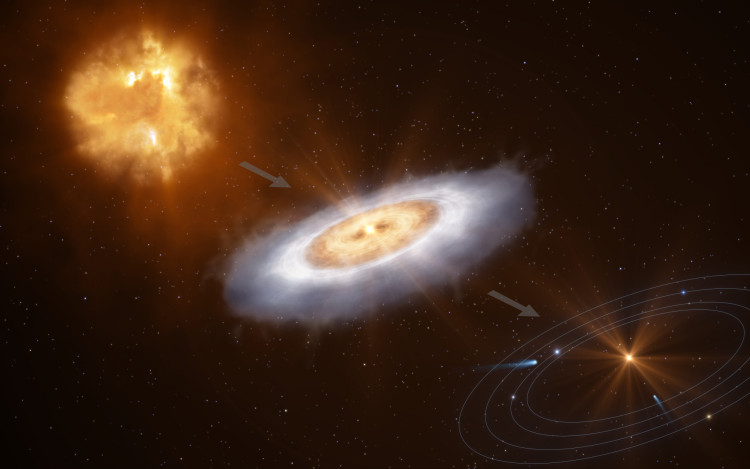When a cloud of gas and dust collapses in the universe, a star forms at its center. A disk of gas and dust orbits around the star. The material in the disk clumps together over several million years to form comets, asteroids and eventually planets.
Ratio of water to heavy water
Astronomers have previously discovered water around stars, disks, comets and planets, but until now, data on the precise ratio of water to heavy water in the disk of gas and dust orbiting a young star was lacking. From the ratio of water (H2O) to heavy water (HDO), astronomers can deduce when and where the water formed.
Astronomers have now found water and heavy water in the disk around the star V883 Orionis, about 1,300 light years from Earth in the constellation Orion. The disk of V883 Orionis is, for reasons not yet fully clarified, warmer than similar disks. "As a result, water is no longer icy, but gaseous, and we can detect that with telescopes." says John J. Tobin, astronomer at the National Radio Astronomy Observatory in the U.S. and lead author. Tobin was a researcher at Leiden University from 2014 to 2016.
Text continues after the video.
The missing link for water in the solar system (video). Astronomers have used ALMA to unravel the chemical signature of gaseous water and heavy water in the planet-forming disk V883 Orionis. (c) ESO [YouTube | various formats]
Beginning and end
Using the Atacama Large Millimeter/submillimeter Array (ALMA), the astronomers were not only able to detect the water, but also determine the ratio of water to heavy water and map its distribution within the disk.
The composition of water in the disk is very similar to that of cold star-forming clouds and comets in our own solar system. "So the ratio of heavy water to water is the same at the beginning as well as at the end of the path that water travels," says co-author Margot Leemker, PhD candidate at the Leiden Observatory. "That confirms the idea that water is already being formed in interstellar space and that it ended up on comets and planets relatively unchanged. Water has probably traveled this route when it comes to our sun and to our Earth as well."
In the future, the researchers want to study the path of water in more detail. One way to do this is with the Extremely Large Telescope under construction and the associated METIS instrument being developed under the leadership of the Netherlands.
Scientific article
Deuterium-enriched water ties planet-forming disks to comets and protostars. By: J.J. Tobin et al. In: Nature, 8 March 2023. [original | preprint (pdf)]

From gas cloud through disk to planetary system (artist's impression). This schematic shows how a gas cloud collapses into a star with a disk in which a planetary system can eventually form. In all stages, water and heavy water appear to be present in the same proportions. (c) ESO/L. Calçada [large format | various resolutions]
